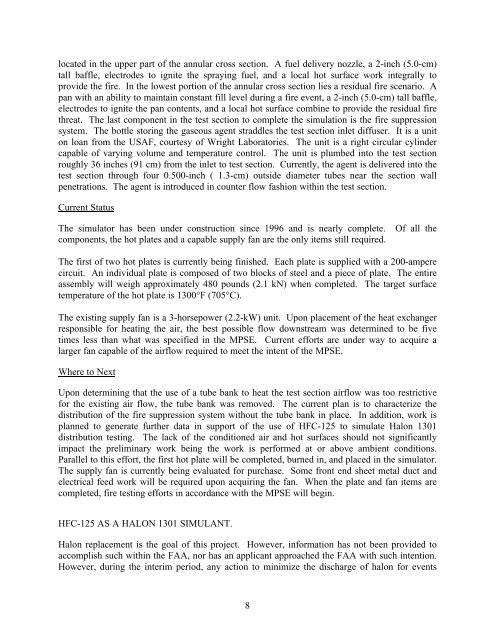FAA Engine Compartment Halon Replacement Project Background ...
FAA Engine Compartment Halon Replacement Project Background ...
FAA Engine Compartment Halon Replacement Project Background ...
You also want an ePaper? Increase the reach of your titles
YUMPU automatically turns print PDFs into web optimized ePapers that Google loves.
located in the upper part of the annular cross section. A fuel delivery nozzle, a 2-inch (5.0-cm)<br />
tall baffle, electrodes to ignite the spraying fuel, and a local hot surface work integrally to<br />
provide the fire. In the lowest portion of the annular cross section lies a residual fire scenario. A<br />
pan with an ability to maintain constant fill level during a fire event, a 2-inch (5.0-cm) tall baffle,<br />
electrodes to ignite the pan contents, and a local hot surface combine to provide the residual fire<br />
threat. The last component in the test section to complete the simulation is the fire suppression<br />
system. The bottle storing the gaseous agent straddles the test section inlet diffuser. It is a unit<br />
on loan from the USAF, courtesy of Wright Laboratories. The unit is a right circular cylinder<br />
capable of varying volume and temperature control. The unit is plumbed into the test section<br />
roughly 36 inches (91 cm) from the inlet to test section. Currently, the agent is delivered into the<br />
test section through four 0.500-inch ( 1.3-cm) outside diameter tubes near the section wall<br />
penetrations. The agent is introduced in counter flow fashion within the test section.<br />
Current Status<br />
The simulator has been under construction since 1996 and is nearly complete. Of all the<br />
components, the hot plates and a capable supply fan are the only items still required.<br />
The first of two hot plates is currently being finished. Each plate is supplied with a 200-ampere<br />
circuit. An individual plate is composed of two blocks of steel and a piece of plate. The entire<br />
assembly will weigh approximately 480 pounds (2.1 kN) when completed. The target surface<br />
temperature of the hot plate is 1300°F (705°C).<br />
The existing supply fan is a 3-horsepower (2.2-kW) unit. Upon placement of the heat exchanger<br />
responsible for heating the air, the best possible flow downstream was determined to be five<br />
times less than what was specified in the MPSE. Current efforts are under way to acquire a<br />
larger fan capable of the airflow required to meet the intent of the MPSE.<br />
Where to Next<br />
Upon determining that the use of a tube bank to heat the test section airflow was too restrictive<br />
for the existing air flow, the tube bank was removed. The current plan is to characterize the<br />
distribution of the fire suppression system without the tube bank in place. In addition, work is<br />
planned to generate further data in support of the use of HFC-125 to simulate <strong>Halon</strong> 1301<br />
distribution testing. The lack of the conditioned air and hot surfaces should not significantly<br />
impact the preliminary work being the work is performed at or above ambient conditions.<br />
Parallel to this effort, the first hot plate will be completed, burned in, and placed in the simulator.<br />
The supply fan is currently being evaluated for purchase. Some front end sheet metal duct and<br />
electrical feed work will be required upon acquiring the fan. When the plate and fan items are<br />
completed, fire testing efforts in accordance with the MPSE will begin.<br />
HFC-125 AS A HALON 1301 SIMULANT.<br />
<strong>Halon</strong> replacement is the goal of this project. However, information has not been provided to<br />
accomplish such within the <strong>FAA</strong>, nor has an applicant approached the <strong>FAA</strong> with such intention.<br />
However, during the interim period, any action to minimize the discharge of halon for events<br />
8
















